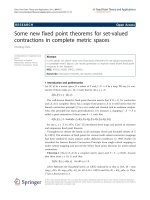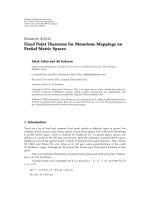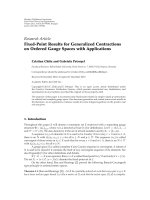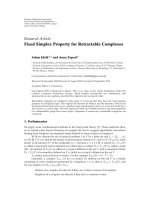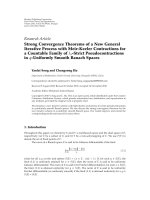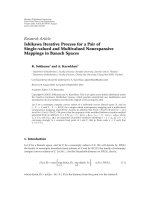Báo cáo hóa học: "Research Article Fixed Point Theorems for a Weaker Meir-Keeler Type ψ-Set Contraction in Metric Spaces" potx
Bạn đang xem bản rút gọn của tài liệu. Xem và tải ngay bản đầy đủ của tài liệu tại đây (487.56 KB, 8 trang )
Hindawi Publishing Corporation
Fixed Point Theory and Applications
Volume 2009, Article ID 129124, 8 pages
doi:10.1155/2009/129124
Research Article
Fixed Point Theorems for a Weaker Meir-Keeler
Ty p e ψ-Set Contraction in Metric Spaces
Chi-Ming Chen and Tong-Huei Chang
Department of Applied Mathematics, National Hsinchu University of Education, Hsinchu 300, Taiwan
Correspondence should be addressed to Tong-Huei Chang,
Received 25 March 2009; Accepted 19 June 2009
Recommended by Marlene Frigon
We define a weaker Meir-Keeler type function and establish the fixed point theorems for a weaker
Meir-Keeler type ψ-set contraction in metric spaces.
Copyright q 2009 C M. Chen and T H. Chang. This is an open access article distributed under
the Creative Commons Attribution License, which permits unrestricted use, distribution, and
reproduction in any medium, provided the original work is properly cited.
1. Introduction and Preliminarie
In 1929, Knaster et al. 1 had proved the well-known KKM theorem on n-simplex. Besides,
in 1961, Fan 2 had generalized the KKM theorem to an infinite dimensional topological
vector space. Later, Amini et al. 3 had introduced the class of KKM-type mappings on metric
spaces and established some fixed point theorems for this class. In this paper, we define a
weaker Meir-Keeler type function and establish the fixed point theorems for a weaker Meir-
Keeler type ψ-set contraction in metric spaces.
Throughout this paper, by R
we denote the set of all real nonnegative numbers, while
N is the set of all natural numbers. We digress briefly to list some notations and review some
definitions. Let X and Y be two Hausdorff topological spaces, and let T : X → 2
Y
be a set-
valued mapping. Then T is said to be closed if its graph G
T
{x, y ∈ X × Y : y ∈ Tx}
is closed. T is said to be compact if the image TX of X under T is contained in a compact
subset of Y.IfD is a nonempty subset of X, then D denotes the class of all nonempty finite
subsets of D. And, the following notations are used:
i Tx{y ∈ Y : y ∈ Tx},
ii TA∪
x∈A
Tx,
iii T
−1
y{x ∈ X : y ∈ Tx}, and
iv T
−1
B{x ∈ X : Tx ∩ B
/
φ}.
2 Fixed Point Theory and Applications
Let M, d be a metric space, X ⊂ M and δ>0. Let B
M
X, δ{x ∈ M : dx, X δ},
and let N
M
X, δ{x ∈ M : dx, X <δ}.
Suppose that X is a bounded subset of a metric space M, d. Then we define the
following
i coX∩{B ⊂ M : B is a closed ball in M such that X ⊂ B},and
ii X is said to be subadmissible 3, if for each A ∈X, coA ⊂ X.
In 1996, Chang and Yen 4 introduced the family KKMX, Y on the topological vector
spaces and got results about fixed point theorems, coincidence theorems, and its applications
on this family. Later, Amini et al. 3 introduced the following concept of the KKMX, Y
property on a subadmissible subset of a metric space M, d.
Let X be an nonempty subadmissible subset of a metric space M, d,andletY a
topological space. If T,F : X
→ 2
Y
are two set-valued mappings such that for any A ∈X,
TcoA ⊂ FA, then F is called a generalized KKM mapping with respect to T.Ifthe
set-valued mapping T : X → 2
Y
satisfies the requirement that for any generalized KKM
mapping F with respest to T, the family {
Fx : x ∈ X} has finite intersection property, then
T is said to have the KKM property. The class KKMX, Y is denoted to be the set {T : X →
2
Y
: T has the KKM property}.
Recall the notion of the Meir-Keeler type function. A function ψ : R
→ R
is said to
be a Meir-Keeler type function see 5, if for each η ∈ R
, there exists δ δη > 0 such that
for t ∈ R
with η ≤ t<η δ, we have ψt <η.
We now define a new weaker Meir-Keeler type function as follows.
Definition 1.1. We call ψ : R
→ R
a weaker Meir-Keeler type function, if for each η>0,
there exists δ>0 such that for t ∈ R
with η ≤ t<η δ, and there exists n
0
∈ N such that
ψ
n
0
t <η.
A function ψ : R
→ R
is said to be upper semicontinuous, if for each t
0
∈ R
,
lim
t → t
0
sup ψt ≤ ψt
0
. Recall also that ψ : R
→ R
is said to be a comparison function
see 6 if it is increasing and lim
n →∞
ψ
n
t0. As a consequence, we also have that for each
t>0, ψt <t,andψ00, ψ is continuous at 0. We generalize the comparison function to
be the other form, as follows.
Definition 1.2. We call ψ : R
→ R
a generalized comparison function, if ψ is upper
semicontinuous with ψ00andψt <tfor all t>0.
Proposition 1.3. If ψ : R
→ R
is a generalized comparison function, then there exists a strictly
increasing, continuous function α : R
→ R
such that ψt ≤ αt <t, for all t>0.
Proof. Let φtt − ψt. Since ψ : R
→ R
is an upper semicontinuous function, hence it
attains its minimum in any closed bounded interval of R
.
For each n ∈ N, we first define four sequences {a
n
}, {b
n
}, {c
n
},and{d
n
} as follows:
i a
n
min
t∈n,n1
φt,
ii b
n
min
t∈1/n1,1/n
φt,
iii c
1
,d
1
min{a
1
,b
1
},
iv c
n
min{c
1
,a
1
,a
2
, ,a
n
} for n ≥ 2, and
v d
n
min{c
1
,b
1
,b
2
, ,b
n
, 1/nn 1} for n ≥ 2.
Fixed Point Theory and Applications 3
And, we next let a function α : R
→ R
satisfy the following:
1 α00,αnn − c
n
,α1/n1/n − d
n
,
2 if n ≤ t ≤ n 1, then
α
t
t − n
α
n 1
n 1 − t
α
n
, 1.1
3 if 1/n 1 ≤ t ≤ 1/n, then
α
t
α
1
n 1
n
n 1
α
1
n
− α
1
n 1
t −
1
n 1
. 1.2
Then by the definition of the function α, we are easy to conclude that α is strictly increasing,
continuous. We complete the proof by showing that ψt ≤ αt for all t>0.
If n ≤ t ≤ n 1, then
α
t
t − n
α
n 1
n 1 − t
α
n
t − c
n
t − n
c
n
− c
n1
≥ t −
t − ψ
t
t − n
c
n
− c
n1
≥ ψ
t
.
1.3
If 1/n 1 ≤ t ≤ 1/n, then
α
t
α
1
n 1
n
n 1
α
1
n
− α
1
n 1
t −
1
n 1
t − d
n
d
n
− d
n1
n 1
− n
n 1
t
≥ t −
t − ψ
t
d
n
− d
n1
n 1
− n
n 1
t
≥ ψ
t
.
1.4
So ψt ≤ αt for all t>0.
Since αn <nand α1/n < 1/n for all n ∈ N,soαt <tfor all t>0.
Proposition 1.4. If ψ : R
→ R
is a generalized comparison function, then there exists a strictly
increasing, continuous function α : R
→ R
such that
ψ
t
≤ α
t
<t, for all t>0,
lim
t →∞
α
t
∞.
1.5
Proof. By Proposition 1.3, there exists a strictly increasing, continuous function
α : R
→ R
such that ψt ≤ αt, for all t>0. So, we may assume that lim
t →∞
αt∞, by letting
αt
αtt/2 for all t ∈ R
.
4 Fixed Point Theory and Applications
Remark 1.5. In the above case, the function α is invertible. If for each t>0, we let α
0
t
t and α
−n
tα
−1
α
−n1
t for all n ∈ N, then we have that lim
n →∞
α
−n
t∞;thatis,
lim
n →∞
α
n
t0.
Proof. We claim that lim
n →∞
α
n
t0, for t>0. Suppose that lim
n →∞
α
−n
tη for some
positive real number η. Then
η lim
n →∞
α
−n
t
α
−1
lim
n →∞
α
−n1
t
α
−1
η
>η, 1.6
which is a contradiction. So lim
n →∞
α
n
t0.
We now are going to give the axiomatic definition for the measure of noncompactness
in a complete metric space.
Definition 1.6. Let M, d be a metric space, and let BM the family of bounded subsets of
M. A map
Φ : B
M
→
0, ∞
1.7
is called a measure of noncompactness defined on M if it satisfies the following properties:
iΦD
1
0 if and only if D
1
is precompact, for each D
1
∈ BM,
iiΦ
D
1
ΦD
1
, for each D
1
∈ BM,
iiiΦD
1
∪ D
2
max{ΦD
1
, ΦD
2
}, for each D
1
,D
2
∈ BM,
ivΦD
1
ΦcoD
1
, for each D
1
∈ BM.
The above notion is a generalization of the set measure of noncompactness in metric
spaces. The following α-measure is a well-known measure of noncompactness.
Definition 1.7. Let M, d be a complete metric space, and let BM the family of bounded
subsets of M. For each D ∈ BM, we define the set measure of noncompactness αD by:
α
D
inf
ε>0: D can be covered by finitely many sets with diameter ε
. 1.8
Definition 1.8. Let X be a nonempty subset of a metric space M, d. If a mapping T : X → 2
M
with for each A ⊂ X, A and TA are bounded, then T is called
i a k-set contraction, if for each A ⊂ X, αTA ≤ kαA, where k ∈ 0, 1,
ii a weaker Meir-Keeler type ψ-set contraction, if for each A ⊂ X, αTA ≤ ψαA,
where ψ : R
→ R
is a weaker Meir-Keeler type function,
iii a generalized comparison comparison type ψ-set contraction, if for each A ⊂ X,
αTA ≤ ψαA, where ψ : R
→ R
is a generalized comparison comparison
function.
Remark 1.9. It is clear that if T : X → 2
M
is a k-set contraction, then T is a weaker Meir-Keeler
type ψ-set contraction, but the converse does not hold.
Fixed Point Theory and Applications 5
2. Main Results
Using the conception of the weaker Meir-Keeler type function, we establish the following
important theorem.
Theorem 2.1. Let X be a nonempty bounded subadmissible subset of a metric space M, d.If
T : X → 2
X
is a weaker Meir-Keeler type ψ-set contraction with for each t ∈ R
, {ψ
n
t}
n∈N
is
nonicreasing, then X contains a precompact subadmissible subset K with TK ⊂ K.
Proof. Take y ∈ X,andlet
X
0
X, X
1
co
T
X
0
∪
y
,
X
n1
co
T
X
n
∪
y
, for each n ∈ N.
2.1
Then
1 X
n
is a subadmissible subset of X, for each n ∈ N;
2 TX
n
⊂ X
n1
⊂ X
n
, for each n ∈ N.
Since T : X → 2
X
is a weaker Meir-Keeler type ψ-set contraction, then αTX
n
≤
ψαX
n
and αX
n1
αcoTX
n
∪{y} ≤ αTX
n
. Hence, we conclude that αX
n
≤
ψ
n
αX.
Since {ψ
n
αX}
n∈N
is nonincreasing, it must converge to some η with η ≥ 0; that
is, lim
n →∞
ψ
n
αX η ≥ 0. We now claim that η 0. On the contrary, assume that η>
0.Then by the definition of the weaker Meir-Keeler type function, there exists δ>0 such that
for each A ⊂ X with η ≤ αA <η δ, there exists n
0
∈ Nsuch that ψ
n
0
αA <η.Since
lim
n →∞
ψ
n
αX η, there exists m
0
∈ N such that η ≤ ψ
m
αX <η δ, for all m ≥ m
0
.
Thus, we conclude that ψ
m
0
n
0
αX <η. So we get a contradiction. So lim
n →∞
ψ
n
αX 0,
and so lim
n →∞
αX
n
0.
Let X
∞
∩
n∈N
X
n
. Then X
∞
is a nonempty precompact subadmissible subset of X,and
by 2, we have TX
∞
⊂ X
∞
.
Remark 2.2. In the process of the proof of Theorem 2.1, we call the set X
∞
a Meir-Keeler type
precompact-inducing subadmissible subset of X.
Applying Proposition 1.3, 1.4,andRemark 1.5, we are easy to conclude the following
corollary.
Corollary 2.3. Let X be a nonempty bounded subadmissible subset of a metric space M, d.If
T : X → 2
X
is a generalized comparison (comparison) type ψ-set contraction, then X contains a
precompact subadmissible subset K with TK ⊂ K.
Proof. The proof is similar to the proof of Theorem 2.1; we omit it.
Remark 2.4. In the process of the proof of Corollary 2.3, we also call the set X
∞
a generalized
comparison type precompact-inducing subadmissible subset of X.
Corollary 2.5. Let X be a nonempty bounded subadmissible subset of a metric space M, d.IfT :
X → 2
X
is a k-set contraction, then X contains a precompact subadmissible subset K with TK ⊂ K.
6 Fixed Point Theory and Applications
Following the concepts of the KKMX, Y family see 3, we immediately have the
following Lemma 2.6.
Lemma 2.6. Let X be a nonempty subadmissible subset of a metric space M, d, and let Y a
topological spaces. Then T|
D
∈ KKMD, Y, whenever T ∈ KKMX, Y, and D is a nonempty
subadmissible subset of X.
We now concern a fixed point theorem for a weaker Meir-Keeler type ψ-set contraction
in a complete metric space, which needs not to be a compact map.
Theorem 2.7. Let X be a nonempty bounded subadmissible subset of a metric space M, d.IfT ∈
KKMX, X is a weaker Meir-Keeler type ψ-set contraction with for each t ∈ R
, {ψ
n
t}
n∈N
is
nonicreasing, and closed with TX ⊂ X,thenT has a fixed point in X.
Proof. By the same process of Theorem 2.1, we get a weaker Meir-Keeler type precompact-
inducing subadmissible subset X
∞
of X. Since TX ⊂ X and TX
n1
⊂ TX
n
⊂ TX for
each n ∈ N, we have
TX
n1
⊂ TX
n
⊂ X for each n ∈ N. Since αTX
n
→ 0asn →∞,
by the above Lemma 2.6, we have that
TX
∞
is a nonempty compact subset of X.
Since T ∈ KKMX, X and X
∞
is a nonempty subadmissible subset of X,by
Lemma 2.6, T|
X
∞
∈ KKMX
∞
,X.
We now claim that for each ε, there exists an x
ε
∈ X
∞
such that Bx
ε
,ε ∩ Tx
ε
/
φ.If
the above statement is not true, then there exists ε
such that Bx, ε
∩Txφ, for all x ∈ X
∞
.
Let K
TX
∞
⊂ X. Then we now define F : X
∞
→ 2
K
by
F
x
K \ N
x, ε
, for each x ∈ X
∞
. 2.2
Then
1 Fx is compact, for each x ∈ X
∞
,and
2 F is a generalized KKM mapping with respect to T|
X
∞
.
We prove 2 by contradiction. Suppose F is not a generalized KKM mapping with respect to
T|
X
∞
. Then there exists A {x
1
,x
2
, ,x
n
}∈X
∞
such that
T
co
{
x
1
,x
2
, ,x
n
}
/
⊆∪
n
i1
F
x
i
. 2.3
Choose μ ∈ co{x
1
,x
2
, ,x
n
} and ν ∈ Tμ ⊂ TX
∞
K such that ν
/
∈∪
n
i1
Fx
i
.From
the definition of F, it follows that ν ∈ Nx
i
,ε
, for each i ∈{1, 2, ,n}. Since μ ∈
co{x
1
,x
2
, ,x
n
}, ν ∈ Tμ, we have μ ∈ coA ⊂ Bν, ε
, which implies that ν ∈ Bμ, ε
.
Therefore, ν ∈ Tμ ∩ Bμ, ε
. This contradicts to Tμ ∩ Bμ, ε
φ. Hence, F is a generalized
KKM mapping with respect to T|
X
∞
.
Since T|
X
∞
∈ KKMX
∞
,X, the family {Fx : x ∈ X
∞
} has the finite intersection
property, and so we conclude that ∩
x∈X
∞
Fx
/
φ. Choose η ∈∩
x∈X
∞
Fx, then η ∈ K\Nx, ε
for all x ∈ X
∞
. But, since η ∈∩
x∈X
∞
Fx and K ⊂ X
∞
⊂∪
x∈X
∞
Nx, 1/2ε
, so there exists an
x
0
∈ X
∞
such that η ∈ Nx
0
,ε
. So, we have reached a contradiction.
Therefore, we have proved that for each ε>0, there exists an x
ε
∈ X
∞
such that
Bx
ε
,ε ∩ Tx
ε
/
φ.Lety
ε
∈ Bx
ε
,ε ∩ Tε. Since y
ε
⊂ K and K is compact, we may assume
Fixed Point Theory and Applications 7
that {y
ε
} converges to some y ∈ K, then x
ε
also converges to y. Since T is closed, we have
y ∈ Ty. This completes the proof.
Corollary 2.8. Let X be a nonempty bounded subadmissible subset of a metric space M, d.IfT ∈
KKMX, X is a generalized composion type ψ-set contraction and closed with
TX ⊂ X,thenT has
a fixed point in X.
Corollary 2.9. Let X be a nonempty bounded subadmissible subset of a metric space M, d.IfT ∈
KKMX, X is a k-set contraction and closed with
TX ⊂ X,thenT has a fixed point in X.
The Φ-spaces, in an abstract convex space setting, were introduced by Amini et al.7.
An abstract convex space X, C consists of a nonempty topological space X and a family C
of subsets of X such that X and φ belong to C, and C is closed under arbitrary intersection.
Let X, C be an abstract convex space, and let Y a topological space. A map T : Y → 2
X
is
called a Φ-mapping if there exists a multifunction F : Y → 2
X
such that
i for each y ∈ Y, A ∈Fy implies ad
C
A ⊂ Ty;
ii Y ∪
x∈X
intF
−1
x.
The mapping F is called a companion mapping of T. Furthermore, if the abstract
convex space X, C which has a uniformity U and U has an open symmetric base family N,
then X is called a Φ-space if for each entourage V ∈ N, there exists a Φ-mapping T : X → 2
X
such that G
T
⊂ V . Following the conceptions of the abstract convex space and the Φ-space,
we are easy to know that a bounded metric space M is an important example of the abstract
convex space, and if X
1
⊂ X and C
1
{C ∩ X
1
: C ∈C}, then X
1
, C
1
is also a Φ-space.
Applying Theorem 2.5 of Amini et al. 7, we can deduce the following theorem in
metric spaces.
Theorem 2.10. Let X be a nonempty subadmissible subset of a metric space M, d.IfT ∈
KKMX, X is compact, then for each r > 0, there exists x
r
∈ X; such that Bx
r
,r ∩ Tx
r
/
φ.
Proof. Consider the family C of all subadmissible subsets of M and for each r>0, x ∈ X,we
set V
r
xBx, r.Let
N
V
r
| V
r
∪
x∈M
x, y
: y ∈ V
r
x
,r>0
. 2.4
Then N is a basis of a uniformity of X. For each V
r
∈ N, we define two set-valued
mappings G, F : X → 2
X
by GxTxV
r
x for each x ∈ X. Then we have
i for each x ∈ X, ad
C
Gx ad
C
V
r
x V
r
xTx ⊂ V
r
Tx;
ii X ∪
x∈X
intG
−1
x.
So, G is a companion mapping of F.ThisimpliesthatF is a Φ-mapping such that
G
F
⊂ V
r
. Therefore, X, C is a Φ-space.
Now we let s : X → X be an identity mapping, all of the the conditions of Theorem
2.5 of Amini et al. 7 are fulfilled, and we can obtain the results.
8 Fixed Point Theory and Applications
Applying Theorems 2.1 and 2.10, we can conclude the following fixed point theorems.
Theorem 2.11. Let X be a nonempty bounded subadmissible subset of a metric space M, d.IfT∈
KKMX, X is a weaker Meir-Keeler type ψ-set contraction with for each t ∈ R
, {ψ
n
t}
n∈N
is
noincreasing, and closed with TX ⊂ X,thenT has a fixed point in X.
Theorem 2.12. Let X be a nonempty bounded subadmissible subset of a metric space M, d.If
T ∈ KKMX, X is a generalized comparison (comparison) type ψ-set contraction and closed with
TX ⊂ X,thenT has a fixed point in X.
References
1 B. Knaster, C. Kuratowski, and S. Mazurkiewicz, “Ein Beweis des Fixpunksatzes fur n-dimensionale
Simplexe,” Fundamenta Mathematicae, vol. 14, pp. 132–137, 1929.
2 K. Fan, “A generalization of Tychonoff’s fixed point theorem,” Mathematische Annalen, vol. 142, pp.
305–310, 1961.
3 A. Amini, M. Fakhar, and J. Zafarani, “KKM mappings in metric spaces,” Nonlinear Analysis: Theory,
Methods & Applications, vol. 60, no. 6, pp. 1045–1052, 2005.
4 T H. Chang and C L. Yen, “KKM property and fixed point theorems,” Journal of Mathematical Analysis
and Applications, vol. 203, no. 1, pp. 224–235, 1996.
5 A. Meir and E. Keeler, “A theorem on contraction mappings,” Journal of Mathematical Analysis and
Applications, vol. 28, pp. 326–329, 1969.
6 I. A. Rus, Fixed Point Theorems for Multivalued Mappings in Complete Metric Spacs, Cluj University Press,
Cluj-Napoca, Romania, 2001.
7 A. Amini, M. Fakhar, and J. Zafarani, “Fixed point theorems for the class S-KKM mappings in abstract
convex spaces,” Nonlinear Analysis: Theory, Methods & Applications, vol. 66, no. 1, pp. 14–21, 2007.
